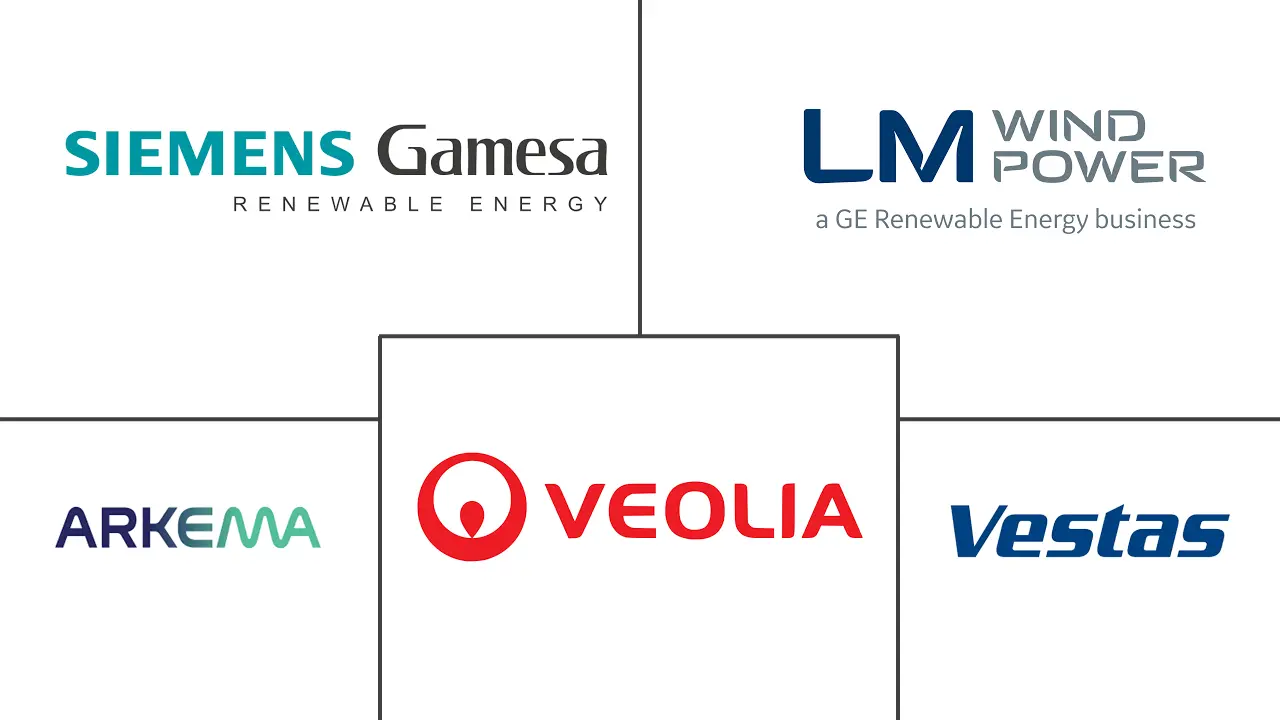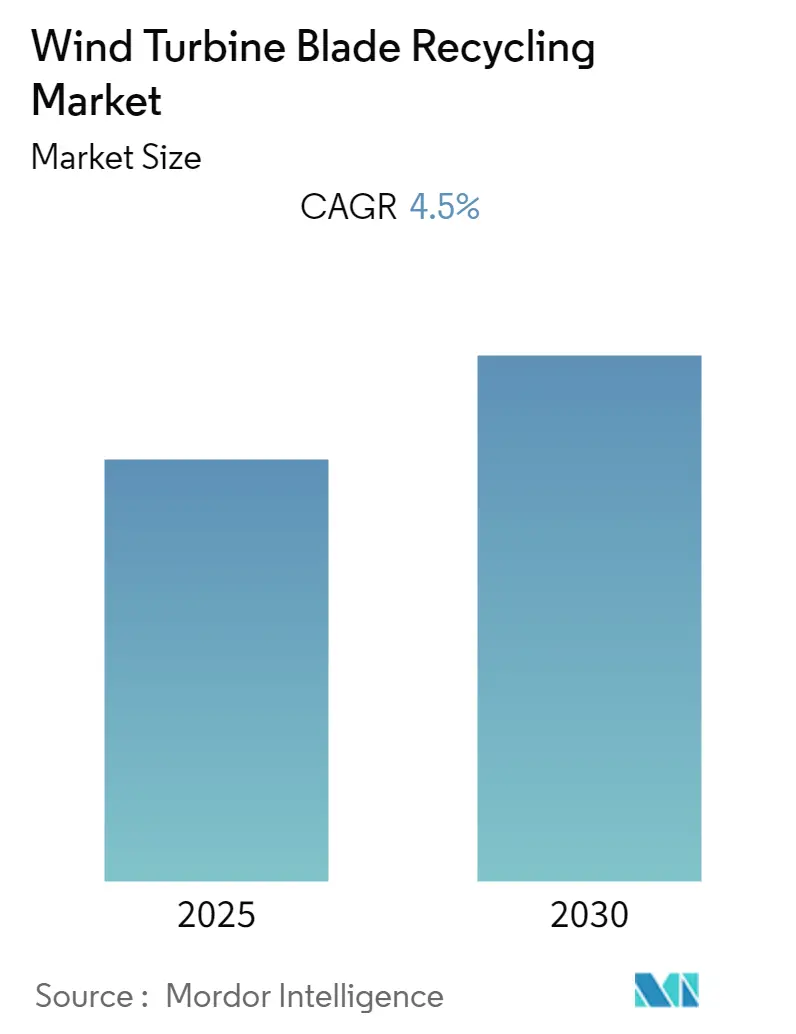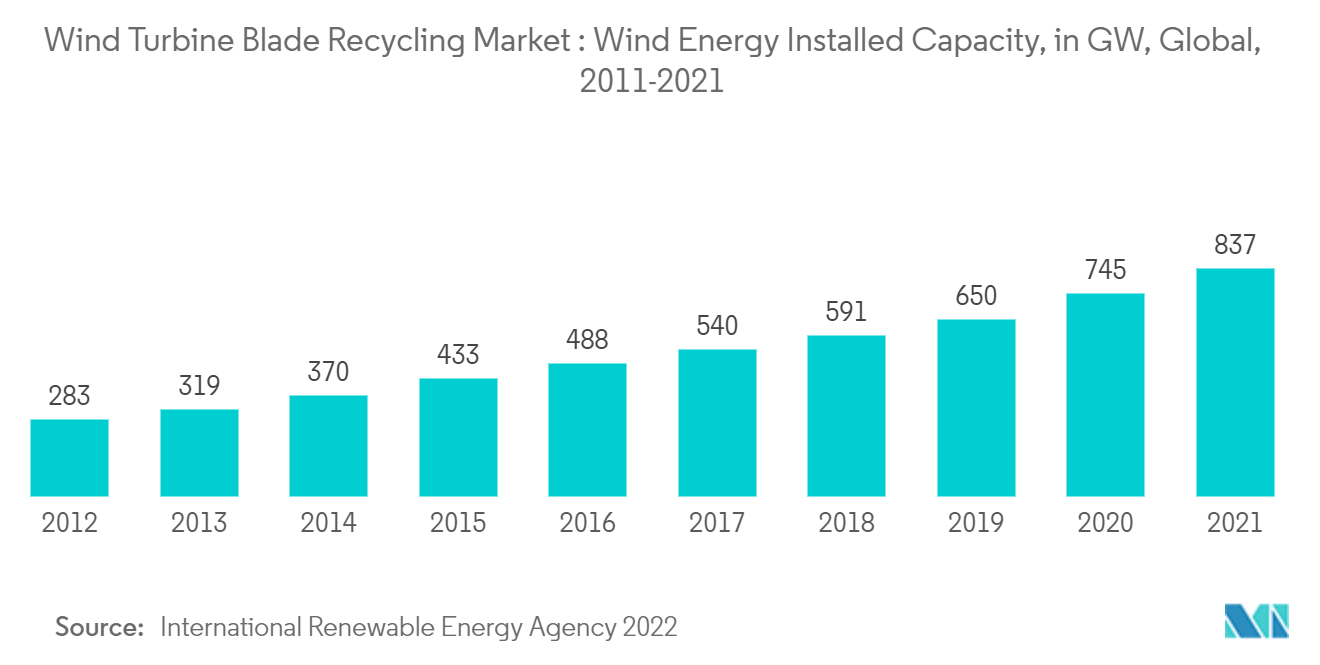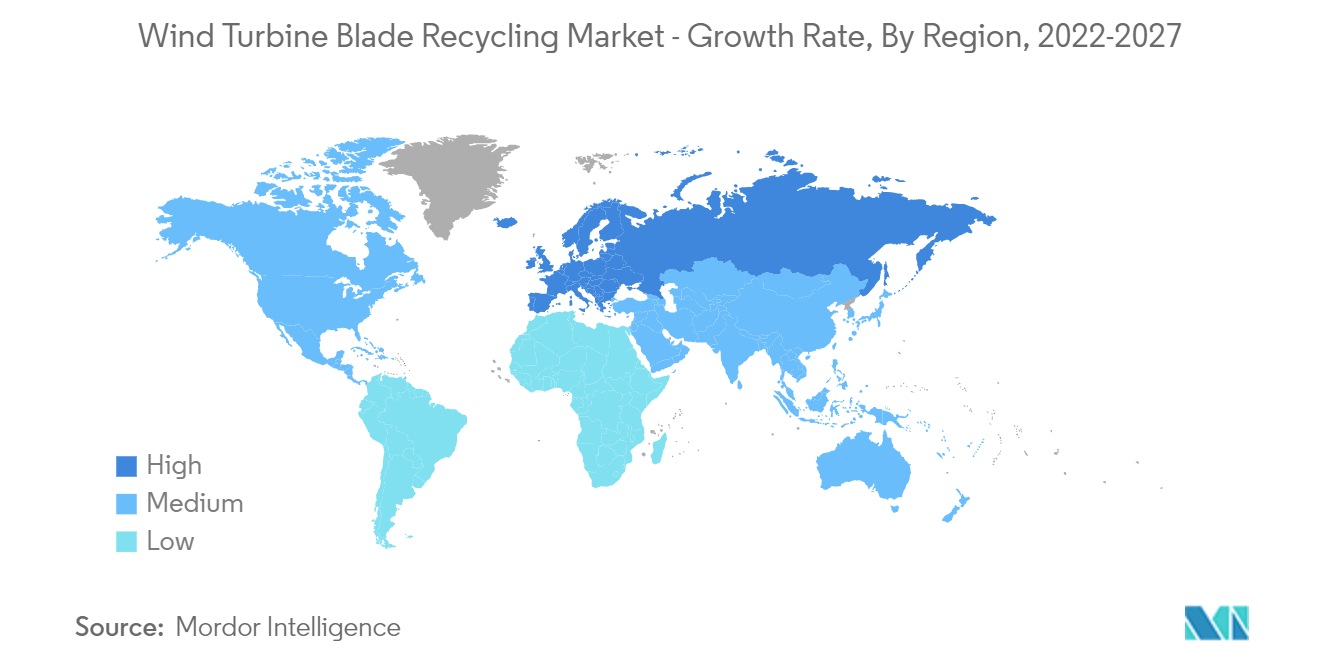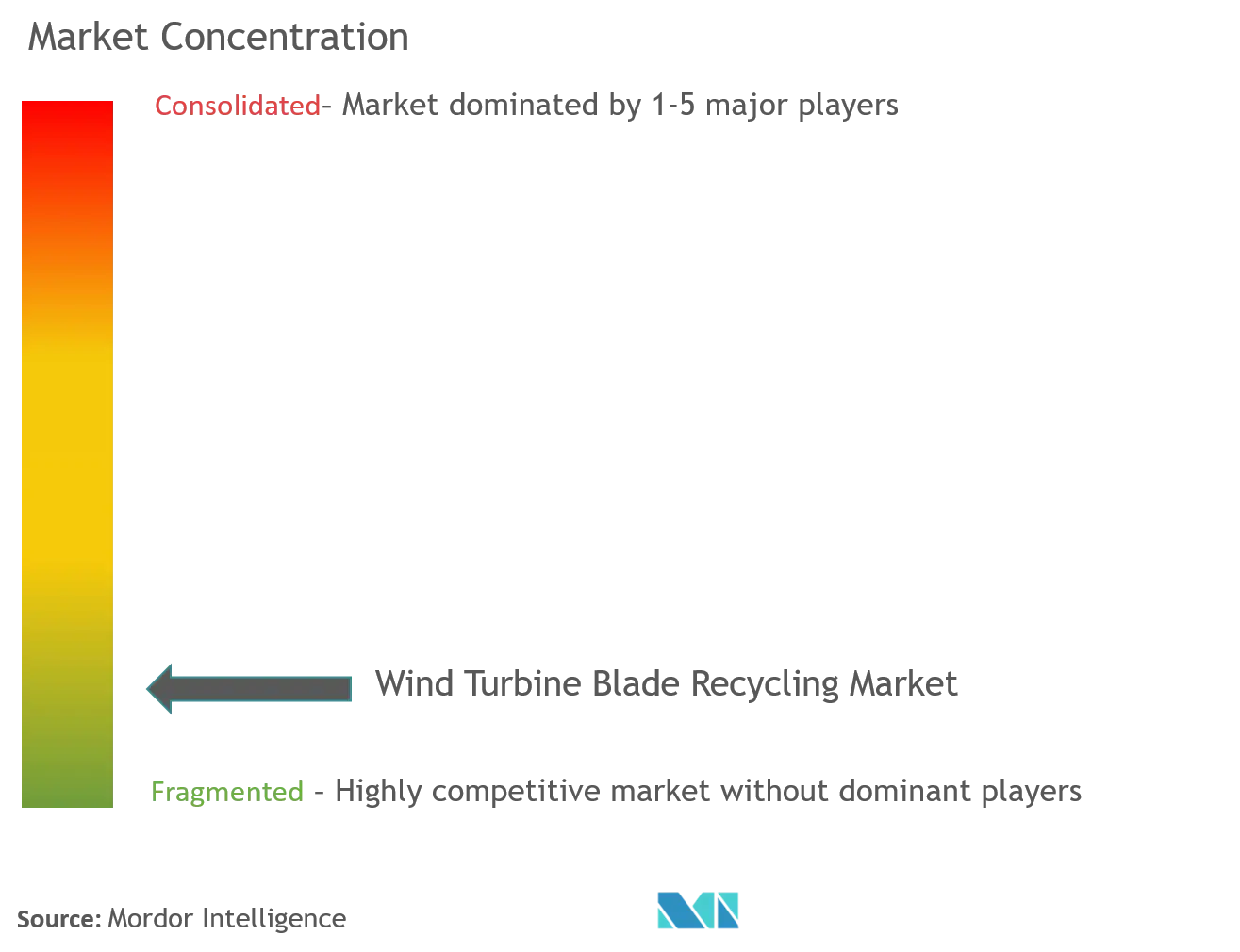Wind Turbine Blade Recycling Market Analysis
The Wind Turbine Blade Recycling Market is expected to register a CAGR of 4.5% during the forecast period.
The market was negatively impacted by COVID-19 in 2020. Presently the market has now reached pre-pandemic levels.
- Over the long term, the increasing number of offshore and onshore wind energy plants for decommissioning is expected to drive the growth of the market.
- On the other note, rising environmental and economic factors due to the wind turbine blade recycling process are hampering the market's growth.
- Nevertheless, according to a recent survey by the University of Cambridge, it is estimated that 43 million tonnes of wind turbine blade waste will be generated by the year 2050. This will create ample opportunities for the wind turbine blade recycling market in the near future.
- Europe is likely to witness significant growth in the wind turbine blade recycling market during the forecast period, mainly due to its favorable government initiatives toward wind turbine blade recycling across the region.
Wind Turbine Blade Recycling Market Trends
Thermo-Chemical Recycling Process (Pyrolysis) to the Dominate the Market
- Wind energy is nowadays one of the energy sources with the fastest growth rate, and it can represent a valuable and economically sustainable solution to the problems of the shortage of fossil fuels and climate change. Global wind energy installed capacity accounted for 837 GW as of 2021. It is carbon-free, and about 85% of turbine components, including steel, copper wire, electronics, and gearing, can be recycled or reused.
- Recycling and reusing composite waste is probably the best choice based on the recent EU directives, while landfilling is the last option.
- Major companies are preferring for thermochemical recycling since it is an advanced technique in which the recovery of the reinforcing fibers through thermal or chemical methods and the matrix (generally with thermosetting nature) is decomposed.
- In October 2022, Carbon Rivers, Inc., a company involved in pyrolysis, commercialized its process to recover mechanically intact glass fiber from decommissioned wind turbine blades. The project is funded by the United States Department of Energy (DOE) in collaboration with the University of Tennessee and successfully scaled up a recovery process that has the capability to divert thousands of tons of waste that would otherwise be destined for landfills.
- Moreover, in March 2022, Kaunas University of Technology (KTU) and the Lithuanian Energy Institute invented a technique for recycling wind turbine blades through a thermochemical recycling process, which involves the breaking of composite materials into basic parts, i.e., fiber and phenol using pyrolysis, this method is essentially waste-free.
- Owing to the above points thermochemical recycling (pyrolysis) process is the best technique that dominates the Wind Turbine Blade Recycling Market.
Europe is Likely to Dominate the Market
- Europe has one of the largest wind power installed capacities across the globe. The region is rich in offshore and onshore wind energy generation across the globe. Recently, it has aimed to decommission most of its aged wind plants.
- As a part of this, on June 2021, European Government announced that the region will decommission around 25,000 tonnes of blades per year by 2025 and 52,000 tonnes a year by 2030. Also, WindEurope, an association based in Brussels that promotes the use of wind power in Europe, has called on landfills to ban decommissioned wind turbine blades by 2025. The initiative includes the commitment of the European wind industry to recycle, reuse or reclaim all decommissioned blades. The ban will become effective by 2025. This, in turn, culminates in the growth of the wind turbine blade recycling market shortly.
- Moreover, in October 2022, The first blade recycling plant project presented in Spain received recognition from the European Union, granting more than EUR 12 million to the consortium in which the project is immersed. The new recycling plant that will be located in Cubillos del Sil (León) is part of Endesa's Future Plan for the Compostilla thermal power plant currently being dismantled.
- Furthermore, many countries such as Germany, the United Kingdom, and Spain have pledged not to decommission European blades outside of Europe. Spain is the second-largest market for wind energy in Europe, joining Wind Europe in this initiative. There is already a ban on landfills in Austria, Germany, Finland, and the Netherlands.
- Owing to the above points, Europe is likely to dominate the wind turbine blade recycling market during the forecast period.
Wind Turbine Blade Recycling Industry Overview
The Wind Turbine Blade Recycling Market is moderately fragmented. Some of the major companies (in no particular order) include LM Wind Power (a GE Renewable Energy business), Siemens Gamesa Renewable Energy SA, Vestas Wind Systems A/S, Veolia Environnement S.A., and Arkema S.A.
Wind Turbine Blade Recycling Market Leaders
-
LM Wind Power
-
Siemens Gamesa Renewable Energy SA
-
Vestas Wind Systems A/S
-
Veolia Environnement S.A.
-
Arkema S.A.
- *Disclaimer: Major Players sorted in no particular order
Wind Turbine Blade Recycling Market News
- March 2022: Hitachi Power Solutions commenced 'Blade Total Service,' an advanced service. The company is expected to mitigate the risks of wind power facilities, including deterioration due to wear and tear of rotating blades, the stress imposed by violent winds during typhoons, and damage caused by lightning, by combining Artificial intelligence and other digital technologies with cutting-edge drone technology.
- September 2021: A cross-sector consortium, including LMWind power, ENGIE S.A., Owens Corning, and Arkema S.A.has, announced a groundbreaking project ZEBRA project, to design and manufacture the wind industry's first 100% recyclable wind turbine blade.
Wind Turbine Blade Recycling Industry Segmentation
Wind power is the process by which the wind is used to generate electricity. Wind turbine blades require disposal or recycling when the turbines are decommissioned at the end-of-use stage or when wind farms are being upgraded. The Wind turbine blade recycling Market report is segmented by Blade Material and Recycling Type. By Blade material, the market is segmented into carbon fiber, glass fiber, and other blade materials. By recycling type, the market is segmented into Physical Recycling and Thermo-Chemical Recycling (Pyrolysis). For each segment, the forecasts have been mentioned in USD billion.
| Blade Material | Carbon Fiber |
| Glass Fiber | |
| Other Blade Materials | |
| Recycling Type | Physical Recycling |
| Thermo-Chemical Recycling (Pyrolysis) | |
| Geography | North America |
| Europe | |
| Asia-Pacific | |
| South America | |
| Middle East and Africa |
Wind Turbine Blade Recycling Market Research FAQs
What is the current Wind Turbine Blade Recycling Market size?
The Wind Turbine Blade Recycling Market is projected to register a CAGR of 4.5% during the forecast period (2025-2030)
Who are the key players in Wind Turbine Blade Recycling Market?
LM Wind Power, Siemens Gamesa Renewable Energy SA, Vestas Wind Systems A/S, Veolia Environnement S.A. and Arkema S.A. are the major companies operating in the Wind Turbine Blade Recycling Market.
Which is the fastest growing region in Wind Turbine Blade Recycling Market?
Europe is estimated to grow at the highest CAGR over the forecast period (2025-2030).
Which region has the biggest share in Wind Turbine Blade Recycling Market?
In 2025, the Asia-Pacific accounts for the largest market share in Wind Turbine Blade Recycling Market.
What years does this Wind Turbine Blade Recycling Market cover?
The report covers the Wind Turbine Blade Recycling Market historical market size for years: 2021, 2022, 2023 and 2024. The report also forecasts the Wind Turbine Blade Recycling Market size for years: 2025, 2026, 2027, 2028, 2029 and 2030.
Our Best Selling Reports
Wind Turbine Blade Recycling Industry Report
Statistics for the 2025 Wind Turbine Blade Recycling market share, size and revenue growth rate, created by Mordor Intelligence™ Industry Reports. Wind Turbine Blade Recycling analysis includes a market forecast outlook for 2025 to 2030 and historical overview. Get a sample of this industry analysis as a free report PDF download.

